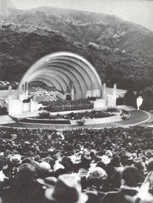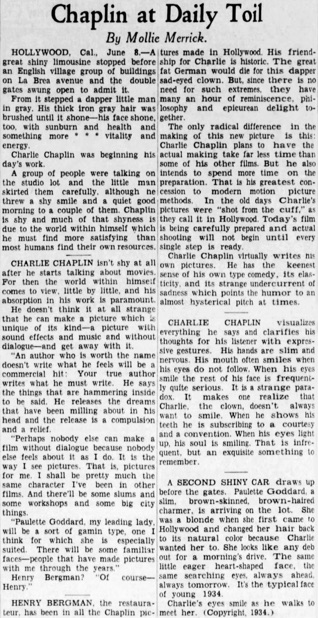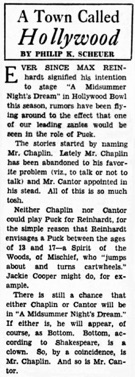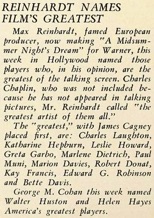Modern Times 1935 1936 1937 next previous
Modern Times Clippings 88/382
Mollie Merrick, Spokesman-Review, Spokane, Wash., June 6, 1934.
Easter Sunrise Service, Hollywood Bowl, Los Angeles, Works
Progress Administration Guide to California, New York 1939
& Reinhardt Names
Film‘s Greatest (...)
Charles Chaplin, who was not included because he has
not appeared in talking pictures, Mr. Reinhardt called „the greatest
artist of them all.“
(...) Motion Picture Herald, March 2, 1935
& Chaplin To Play In
Shakespeare At Bowl
New York – Charles Chaplin is understood to have
consented to appear in the production of „Midsummer
Night‘s Dream“ which Max Reinhardt will stage at the Hollywood
Bowl in September. His role is not yet announced.
(...) Hollywood Reporter, Los Angeles, Cal., June 27, 1934
& A Town Called
Hollywood
BY PHILIP K. SCHEUER
EVER SINCE MAX REINhardt signified his intention
to stage „A Midsummer Night‘s Dream“ in Hollywood
Bowl this season, rumors have been flying around to the
effect that one of our leading zanies would be seen
in the role of Puck.
The stories started by naming Mr. Chaplin. Lately Mr.
Chaplin has been abandoned to his favorite problem
(viz., to talk or not to talk) and Mr. Cantor appointed in his
stead. All of this is so much tosh.
Neither Chaplin nor Cantor could play Puck for
Reinhardt, for the simple reason that Reinhardt
envisages a Puck between the ages of 13 and 17 – a Spirit
of the Woods, of Mischief, who „jumps about and
turns cartwheels.“ Jackie Coogan might do, for example.
There is still a chance that either Chaplin
or Cantor will be in „A Midsummer Night‘s Dream.“ If either
is, he will appear, of course, as Bottom. Bottom,
according to Shakespeare, is a clown. So, by coincidence,
is Mr. Chaplin. And so is Mr. Cantor.
(...) Los Angeles Times, Los Angeles, Cal.,
Aug. 12, 1934
„Charlie‘s eyes smile as he walks to meet her“
Editorial content. „Chaplin at Daily Toil
By Mollie Merrick.
HOLLYWOOD, Cal., June 8. – A great shiny limousine
stopped before an English village group of buildings
on La Brea avenue and the double gates swung open to
admit it.
From it stepped a dapper little man in gray. His thick iron
gray hair was brushed until it shone – his face shone,
too, with sunburn and health and something more * * * vitality
and energy.
Charlie Chaplin was beginning his day‘s work.
A group of people were talking on the
studio lot and the little man skirted them carefully, although
he threw a shy smile and a quiet good morning
to a couple of them. Chapin is shy and much of that shyness
is due to the world within himself which he must find
more satisfying than most humans find their own resources.
–––
CHARLIE CHAPLIN isn‘t shy at all after he starts talking
about movies. For then the world within himself
comes to view, little by little, and his absorption in his work
is paramount.
He doesn‘t think it at all strange that he can make
a picture which is unique of its kind – a picture
with sound effects and music and without dialogue – and get
away with it.
,An author who is worth the name doesn‘t write what
he feels will be a commercial hit: Your true author
writes what he must write. He says the things that are
hammering inside to be said. He releases the
dreams that have been milling about in his head and the
release is a compulsion and a relief.
,Perhaps nobody else can make a film without dialogue
because nobody else feels about it as I do. It is the
way I see pictures. That is, pictures for me. I shall be pretty
much the same character I‘ve been in other films.
And there‘ll be some slums and some workshops and some
big city things.
,Paulette Goddard, my leading lady, will be a sort
of gamin type, one I think for which she is especially suited.
There will be some familiar faces – people that have
made pictures with me through the years.‘
Henry Bergman? ,Of course – Henry.‘
–––
HENRY BERGMAN, the restaurateur, has been in all the
Chaplin pictures made in Hollywood. His friendship
for Charlie is historic. The great fat German would die for this
dapper sad-eyed clown. But, since there is no need
for such extremes, they have many an hour of reminiscence,
philosophy and epicurean delight together.
The only radical difference in the making of this new
picture is this: Charlie Chaplin plans to have the
actual making take far less time than some of his other films.
But he also intends to spend more time on the
preparation. That is his greatest concession to modern
motion picture methods. In the old days Charlie‘s
picture were ,shot from the cuff,‘ as they call it in Hollywood.
Today‘s film is being carefully prepared and
actual shooting will not begin until every single step
is ready.
Charlie Chaplin virtually writes his own pictures. He has
the keenest sense of his own type comedy, its
elasticity, and its strange undercurrent of sadness which points
the humor to an almost hysterical pitch at times.
–––
CHARLIE CHAPLIN visualizes everything he says and
clarifies his thoughts for his listener with expressive
gestures. His hands are slim and nervous. His mouth often
smiles when his eyes do not follow. When his eyes
smile the rest of his face is frequently quite serious. It is a
strange paradox. It makes one realize that Charlie,
the clown, doesn‘t always want to smile. When he shows his
teeth he is subscribing to a courtesy and a convention.
When his eyes light up. his soul is smiling. That is infrequent,
but an exquisite something to remember.
–––
A SECOND SHINY CAR draws up before the gates.
Paulette Goddard, a slim, brown-skinned, brown-haired
charmer, is arriving on the lot. She was a blonde
when she first came to Hollywood and changed her hair back
to its natural color because Charlie wanted her to.
She looks like any deb out for a morning‘s drive. The same
little eager heart-shaped face, the same searching
eyes, always ahead, always tomorrow. It‘s the typical face
of young 1934.
Charlie‘s eyes smile as he walks to meet her.
(Copyright, 1934.)“
Redaktioneller Inhalt
Modern Times 1935 1936 1937 next previous





